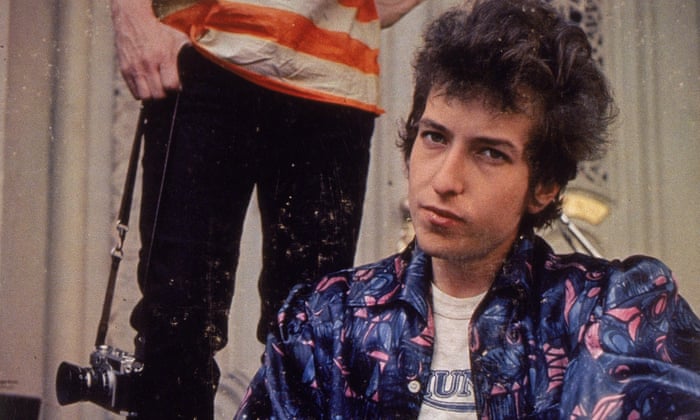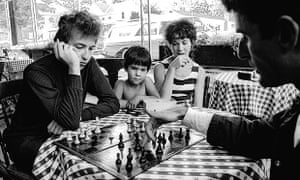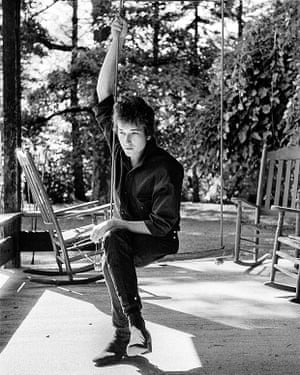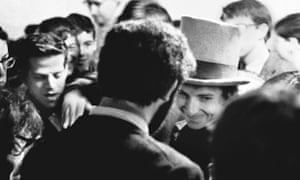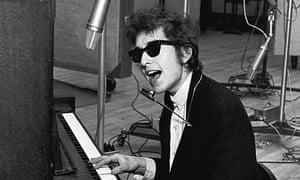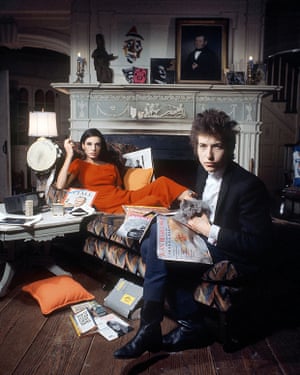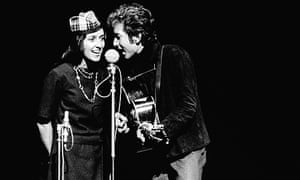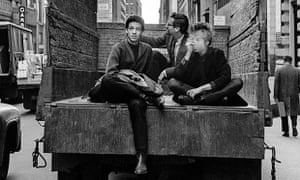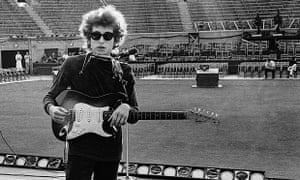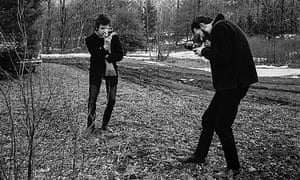On Monday 16th of May, 1966 two of the greatest albums of all time were released. Through archive, interviews and music from The Beach Boys' Pet Sounds and Bob Dylan's Blonde on Blonde, we tell the story of the music from that momentous day.
For the American music lover, the two albums would come to shape music history. Blonde on Blonde is considered Bob Dylan's magnum opus, while Pet Sounds is The Beach Boys' epic journey into the musical mind of Brian Wilson.
Fifty years on, we hear from those who remember that day - musicians who worked on the albums, and teenagers who saved up to buy the records but had a choice to make, Pet Sounds or Blonde on Blonde.
We hear of two lovers who danced in the kitchen to Pet Sounds. Wouldn't it Be Nice played as they talked of the future. On that day in 1966, Bob Dylan was playing in Sheffield, one of his forty or so worldwide shows. One Dylan fan remembers it like it was yesterday. The next day Dylan would play Manchester and be called "Judas".
One day, two musical visions.
A Reduced Listening production for BBC Radio 4.
Acid references, animal run-ins and other fascinating facts about the 50-year-old pop masterpiece
16 May 2016
The story of Pet Sounds is the story of art versus commerce, youthful optimism versus adult cynicism and the independent spirit versus the mundane status quo. It's also a story of tremendous courage. In 1966, 23-year-old Brian Wilson hijacked the
Beach Boys, a multi-million-dollar industry consisting of his two brothers, cousin and childhood friend, to give voice to the sounds he heard in his head and the emotions he felt in his heart. The result was an album that had leading musical figures struggling to match his technical innovation, lyrical depth and melodic genius. Half a century later, it's questionable whether anyone has.
Pet Sounds has become shorthand for a fully realized artistic vision that owes little to trends and everything to the soul. "We were trying to capture spiritual love that couldn't be found anywhere else in the world," Wilson has said. In doing so, he gave popular music one of its finest touchstones.
To celebrate the 50th anniversary of the seminal album's release, here are some little known facts about Pet Sounds' creation.
1. Pet Sounds' lyricist penned jingles for Barbie dolls, Max Factor cosmetics and Gallo wine.In an effort to craft material that moved beyond the Beach Boys' lightweight fun-fun-fun-in-the-sun fare*, Brian Wilson sought to work with a lyricist from outside the band's usual circle. In late 1965, he tapped Tony Asher, a copywriter at the prestigious Carson-Scott advertising agency, who had written campaigns for Mattel toys ("You can tell it's Mattel – It's swell!"), as well as Max Factor, Gallo Wines and a host of other high-profile clients. The pair was loosely acquainted through mutual friends, and had recently crossed paths in the recording studio where Asher was producing advertising jingles. The meeting was short and uneventful, but the urbane and articulate ad man stayed on Wilson's mind.
"A few weeks later, I got a phone call, " recalled Asher in an interview for thePet Sounds 30th-anniversary box set. "And Brian said, 'Listen, I have an album that is overdue. Would you want to help me write it?' I thought it was somebody in the office playing a joke on me.'" After confirming it wasn't a prank, Asher secured a leave of absence from his job and reported for duty at the pop star's Beverly Hills home several days later. Though it may sound like an unusual pairing, Asher's experience turning long meetings with ad clients into crisp copy and memorable slogans made him an ideal partner for Wilson. Most of their writing sessions began with abstract conversations about life and love, which would inevitably seep into their work. As Asher relayed to Nick Kent: "It's fair to say that the general tenor of the lyrics was always his and the actual choice of words was usually mine. I was really just his interpreter."
2. "You Still Believe in Me" was originally called "In My Childhood" and had completely different lyrics.For Asher's first assignment, Wilson handed over a cassette of an instrumental track for a song called "In My Childhood." The composition already had a complete melody and set of lyrics, which Wilson underscored in the arrangement with youthful sounds from a bike horn and bell. But he had grown unhappy with these words and tasked Asher with writing new ones. "That was a good way to start things off," Asher said. "It's a great luxury – at least for a lyricist – to write to tracks because you have a much better sense of what the musical mood of the song is. And here was a case where it was real clear what Brian had in mind."
The next day, Asher returned with the lyrics to "You Still Be Believe in Me" scrawled on a yellow legal pad. The new lyrics were recorded over the "In My Childhood" instrumental track, which retained its innocent horn and bell as the only vestiges of its prior incarnation. "Brian never let me hear the [original] lyric to it," Asher remembered. To date, no trace of the "In My Childhood" verses have ever surfaced.
3. The instrumental "Let's Go Away for a While" was slated to have lyrics.Brian Wilson always had a special fondness for "Let's Go Away For a While," labeling it "the most satisfying piece of music I have ever made." The complex dynamics and elusive theme make it one of the most fully realized arrangements of his career, but he claims it's missing a major component: lyrics.
"The track was supposed to be the backing for a vocal, but I decided to leave it alone," Wilson said in 1967. "It stands up well alone." This revelation would explain why no obvious tune springs from the melodic figures ("Try to hum it!" he challenged years later). Some reports published in the Nineties accuse Capitol Records, anxious for their overdue album, of forcing Brian to use the vocal session to mix Pet Sounds – or even of confiscating the incomplete tapes outright. It remains to be seen whether these tales are based in reality or rock revisionism. Tony Asher, for his part, denies ever penning words for the tune. "I never heard any lyrics to that song, although I understood there were some. I don't know if they were recorded or who wrote them, if in fact they ever existed."
4. "God Only Knows" was written in under an hour.The track has become one of the most beloved in the band's canon, famously praised by Paul McCartney as the greatest song ever written. Its legendary status is even more remarkable considering that it came together in less than an hour. According to a 2015 Guardian interview, Wilson claims that he and Tony Asher composed the song in just 45 minutes. "We didn't spend a lot of time writing it," confirms Asher. "It came pretty quickly. And Brian spent a lot of time working on what ended up being the instrumental parts of that song. But the part that has lyrics really was one of those things that just kinda came out as a whole."
Author Jim Fusilli theorized that the song's title was born out of a love letter Wilson wrote to his wife Marilyn in 1964, signing off with "Yours until God wants us apart." Whatever the true genesis, this reference to God created a dilemma for the two collaborators. "We had lengthy conversations during the writing of 'God Only Knows,'" remembers Asher. "Because unless you were Kate Smith and you were singing 'God Bless America,' no one thought you could say 'God' in a song. No one had done it, and Brian didn't want to be the first person to try it. He said, 'We'll just never get any airplay.'" Though a handful of Southern radio stations banned the song for blasphemy, it was warmly received nearly everywhere else.
5. "God Only Knows" had a sax solo at one point.The intricate vocal round on the bridge of "God Only Knows" serves as the song's heavenly centerpiece. It's jarring to hear anything other than perfectly interlacing harmonies in those eight measures, but the ungainly honk of a saxophone seems especially out of place. Amazingly, that's exactly what Wilson intended at one point. An early mix has a sax solo front and center, rudely interrupting the song's finely wrought musical elegance. He wisely edited the part out soon after.
Wilson spent a great deal of time experimenting with the sonic possibilities of "God Only Knows." He originally sang the song himself before deciding that Carl Wilson's airy tenor was better suited to the piece. "I said my brother Carl will probably be able to impart the message better than I could, so I sacrificed that one," he said in 1996. For the fadeout, he had composed an elaborate 30-second a cappella break. "He had all the Beach Boys, Terry Melcher and two of the Rovell sisters [Wilson's wife Marilyn and her sister Diane] on it," says Bruce Johnston, who had recently joined the band as a full time member after filling in for Brian Wilson on live tour dates. "It just got so overloaded; it was nuts. So he was smart enough to peel it all back." Ultimately the final fadeout has just three voices – a double-tracked Brian Wilson harmonizing with himself on the high and low parts, and Johnston in the middle.
6. The original title of "I Know There's an Answer" caused major conflict within the band.While Brian Wilson was busy writing and recording instrumental tracks forPet Sounds, the rest of the Beach Boys spent early 1966 touring Japan on the back of their most recent hit, a brainless campfire cover of the Regents' "Barbara Ann," which Wilson had tossed off in the fall to fulfill record-company commitments. When the group reconvened in the studio that February to record vocal parts for what they assumed would be another sunny Brian Wilson anthem, one of the first things they heard was a track called "Hang on to Your Ego." Written with the band's road manager Terry Sachen, the lyrics were inspired by Wilson's experience using LSD. The whole band was taken aback by this jarring new direction, but Mike Love reportedly took particular offense to the piece, which he rejected as "a doper song."
"The prevailing drug jargon at the time had it that doses of LSD would shatter your ego, as if that were a positive thing," explained Love in 1996. "I wasn't interested in taking acid or getting rid of my ego." During outtakes from the sessions, Love can be heard belching in the background, singing the lyrics in the manner of Jimmy Durante and James Cagney, and generally clowning around. Clearly he wasn't a fan of the tune. "Mike was very confused by it," confirms Al Jardine. "Mike's a formula hound – if it doesn't have a hook in it, if he can't hear a hook in it, he doesn't want to know about it."
Ultimately, Wilson let Love alter the title to a less inflammatory "I Know There's an Answer," but it was the start of ongoing tensions between the two. Love reportedly found some of Tony Asher's lyrics "nauseating" and dubbed the project "Brian's ego music." Asher recalls Love hissing the immortal phrase "Don't fuck with the formula!" at Wilson during one of the recording dates. While Love dismisses these accusations as "a bunch of bullshit," he's admitted that "some of the words were so offensive to me that I wouldn't even sing 'em."
7. Bruce Johnston is having a conversation about cameras in the background of "Here Today."Lending credence to the rumor that Capitol Records rushed Brian Wilson into completing the album, session musician Steve Douglas claims that the album was mixed in a single nine-hour marathon session. "I remember when Brian turned in Pet Sounds," he said in the 30th-anniversary liner notes. "I was working as a producer at Capitol at the time. It was full of noise. You could hear him talking in the background. It was real sloppy. He had spent all this time making the album, and zip – dubbed it down in one day or something like that."
The tracks were mostly tweaked to Beach Boy perfection before they were pressed to vinyl, but keen-eared fans have noticed talking during the instrumental break of "Here Today." Beginning at 1:55, Bruce Johnston can be heard having a conversation with a photographer about a camera he purchased on the band's recent tour of Japan. A few seconds later, Brian Wilson's voice cuts through, bellowing, "Top, please!" – his way of asking the engineer to rewind the tape so the band could attempt another vocal take. This quirk was omitted from the 1996 stereo mix of the album, apparently at Wilson's request.
8. "Pet Sounds" was written as a potential James Bond theme.The record's bossa nova-flavored title track began life as an instrumental called "Run James Run." The James in question is 007 himself. Perhaps inspired by the 15-second James Bond-esque theme that opens the American version of the Beatles' 1965 Help! soundtrack, Wilson apparently decided to take a stab at a full track. "It was supposed to be a James Bond-theme type of song," Wilson revealed in 1996. "We were gonna try to get it to the James Bond people. But we thought it would never happen, so we put it on the album." The cinematic orchestration hints that Brian Wilson could have had a strong future in film scoring.
9. Brian Wilson sped up his vocals on "Caroline, No " in order to make himself sound younger.For the album's emotional closer, 23-year-old Brian Wilson cast his mind back to his teenage crush on a cheerleader named Carol Mountain. He had been obsessed with the girl as a student, rhapsodizing about her beautiful complexion and long dark hair. By 1966, Wilson had discovered that Mountain was married and still living in their hometown of Hawthorne, not far from his Hollywood home. Though also married, Wilson began to call his unrequited high-school love, who had no inkling of his true feelings until decades later. "He didn't sound drugged or anything, but it was very strange," Mountain told author Peter Ames Carlin. "He'd call at 3 a.m. and want to talk about music. ... But it was nothing inappropriate. It was just a strange thing he was going through, calling and connecting."
Though they didn't meet in person, Wilson grew depressed that the torch he carried for Mountain had begun to dim. "If I saw her today, I'd probably think, 'God, she's lost something,' because growing up does that to people," he explained decades later. He relayed this story to Tony Asher, who penned a chorus in the form of a dialogue between the two: "Oh, Carol, I know." Wilson misheard this as "Caroline, No," giving the song its pleading title. The recording became one of the most heartbreaking tunes ever committed to wax, plodding ahead at a depressive crawl. He played the song to his father (and onetime band manager), Murry Wilson, who advised his son to speed up the tape a full tone to give his voice a sweeter, more youthful quality. The effect made him sound like the lovesick teenager that, in many ways, he still was.
"Caroline, No" was released under Brian Wilson's own name in March 1966, the first solo single for any Beach Boy.
10. Session musicians used Coke cans, water bottles and orange juice jugs for percussion.The arrangements on Pet Sounds boast a dazzling array of percussion previously unseen in the rock-music arena. Sleigh bells, timpani, güiro, vibraphone, bongos and other exotic instruments all add color to the album, but certain sounds aren't instruments at all. In order to create the music in his head, Wilson improvised a number of percussive instruments from whatever he had on hand. For the Latin-tinged "Pet Sounds" track, he encouraged drummer Ritchie Frost to tap two empty Coke cans for a distinctive percussive beat.
Drumming legend Hal Blaine, unofficial chief of the crack team of session musicians known as the Wrecking Crew, had something special up his sleeve for the clip-clop rhythm that kept "God Only Knows" galloping forward. "We used to drink orange juice out of the vending machines," he explained. "I took three of these small six- or eight-ounce plastic orange-drink bottles, and I cut them down to three different sizes in length. And I taped 'em together, and I used a little vibraphone mallet. Brian loved that kind of stuff." Session man Jim Gordon (later of Derek and the Dominos) actually played the OJ bottles, but Hal pulled off a similar trick on the introduction for "Caroline, No," playing upturned Sparkletts water jugs like bongos.
11. Brian Wilson considered bringing a horse into the recording studio.In addition to his meticulous instrumental arrangements and vocal layering, Wilson also spent some sessions making avant-garde recordings with friends and family. These ranged from echo-drenched rounds of "Row, Row, Row Your Boat" stretching over seven minutes, to humorous skits (including a particularly sophomoric one entitled "Dick") and sound effects for a proposed psychedelic comedy album. He would revisit the concept when working on Pet Sounds' follow-up, Smile, later that year, but these early runs were almost totally scrapped.
The only fragment from the tapes can be heard on the final seconds of the album. As the flutes from "Caroline, No" fade away, the melancholic sound of a passing train is heard while dogs wail. The locomotive whistle was sampled off a 1963 effects album called Mister D's Machine ("Train #58, the Owl at Edison, California"), but the barks come from Wilson's own dogs: Banana, a beagle, and Louie, a Weimaraner. Their barking made for an unusual session, but studio chatter reveals that he had a bigger beast in mind.
"Hey Chuck, is it possible we could bring a horse in here if we don't screw anything up?" he can be heard asking engineer Chuck Britz. "I beg your pardon?" comes the stunned reply. But Wilson won't be deterred. "Honest to God, now, the horse is tame and everything!" For whatever reason, he ultimately decided to stick with the canines.
12. The band had a less-than-harmonious relationship with the animals on the cover.The Beach Boys and photographer George Jerman traveled to the San Diego Zoo on February 15th, 1966, to shoot the cover art for their new album. The final image showed five of the bandmates (the newly enlisted Bruce Johnston couldn't appear on the cover for contractual reasons) feeding goats in the children's petting paddock. The scene looks wholesome enough, but apparently the band didn't endear themselves to the zoo staff.
According to an article in the Los Angeles Times, San Diego Zoo officials accused the Beach Boys (reportedly Dennis Wilson in particular) of "mistreating the animals." The group, for their part, claimed that they were the ones who were mistreated. "You know the big white [goat] on the front? The most obnoxious animal I've ever known in my life," Al Jardine complained during a 1966 interview on Hartford's WDRC. "Pushed me, and all of us, all over the place. If you had a little piece of something in your hand, he'd know it. And he'd almost trample you trying to get that thing!" Even decades later, Bruce Johnston never forgot the ill-tempered creatures. "The goats were horrible! They jump all over you and bite. One of them ate my radio. The zoo said we were torturing the animals, but they should have seen what we had to go through. We were doing all the suffering."
13. The record label tried to bury Pet Sounds with a greatest-hits album.Brian Wilson's Pet Sounds odyssey took up more 10 months and cost a then-unheard-of $70,000, making it one of the most expensive albums ever recorded at that time. The Capitol executives were hoping for a hit-packed album to recoup their sizable investment. But when they heard the final mix that April, they were puzzled – and horrified – by the decidedly un-sunny sounds. Instead of a celebration of youth, Capitol got a melancholic musical missive straight from the heart of their young maestro. "It was played at a sales meeting, and the marketing guys were really disappointed and down about the record, because it wasn't the normal 'Surfin' U.S.A.,' 'Help Me, Rhonda,' 'Barbara Ann,' kind of production," remembered A&R rep Karl Engermann. "Capitol didn't see the evolution," Bruce Johnston lamented. "Pet Sounds was so radical compared to the nice 'Barbara Anns' we had been making, which Capitol had been successfully selling and they just wanted more."
Unsure how to market Wilson's introspective artistic statement, Capitol hedged their bets by hastily preparing a greatest-hits compilation and throwing their full promotional machine behind it. Best of the Beach Boyswas rushed into shops less than two months after Pet Sounds' release. It promptly went gold, while Pet Sounds, effectively left to sell on its own merits, barely cracked the Top 10. It was a major drop-off from the Number One million-sellers of prior years. Capitol felt vindicated, and Brian Wilson was crushed. "In my heart of hearts, I think that the reason [Pet Sounds] isn't a billion-selling album is simply that the label didn't believe in Brian," Johnston reflected on the album's 30th anniversary. "They turned their back on him by releasing Best of the Beach Boys. Why wouldn't you allocate a massive budget to promote Pet Sounds? This album is timeless and forever, and the label turned it into an ignored stepchild."
14. Bruce Johnston's Pet Sounds promo trip almost broke up the Who – but inspired the Beatles.If Capitol wasn't going to properly promote Pet Sounds, then Bruce Johnston vowed to do it himself. On May 16th, he began a self-guided London excursion "to do some hustling" for the album, which had been released that very day in the States but had yet to be issued in the U.K. Upon landing, Johnston was immediately befriended by Keith Moon, drummer for the Who and one of England's biggest surf fanatics. Moon played genial host to the American abroad, chauffeuring him to the best clubs, restaurants and parties in his Bentley – specially outfitted with a record player and a stack of the Beach Boys' old records.
The pair attended a taping of the rock television program Ready Steady Go!and dropped by the after-party with Moon's bandmate, John Entwistle. The revelry went on a little too long, and the trio missed the start of Who's gig that evening. When they finally arrived at the venue, they were stunned to discover that the other half of the band – Pete Townshend and Roger Daltrey – had begun playing without them. Enraged, Moon instigated a drunken onstage brawl with his bandmates. "They got in the biggest fight I've ever seen," Johnston confirmed in later years. "Guitars are swinging, everybody's in a frenzy. ... guys were bleeding." When the dust cleared, Moon and Entwistle quit the Who in a huff. Thankfully, the split would prove short-lived.
Bruce Johnston's trip had a much more positive effect on the Beatles. John Lennon and Paul McCartney dropped by Johnston's Waldorf Hotel suite to say hello and scope out this new Beach Boys album that was setting the English music papers abuzz. "John and Paul made me play it twice. They loved it," Johnston said. "We all knew that it was a really wonderful thing to be listening to. There wasn't much to say; it was like collectively watching a great movie, and you go, 'Wow!' and just know it was cool." According to legend, the two Fabs said their farewells and headed to McCartney's nearby apartment to pen a Pet Sounds-style preamble for their lush "Here, There and Everywhere." The track found its way onto Revolver that August, but it was their 1967 follow-up that truly bore influence of Brian Wilson. "Without Pet Sounds, Sgt. Pepper never would have happened," admitted Beatles' producer George Martin. "Pepper was an attempt to equal Pet Sounds."
15. Several songs didn't make the cut for Pet Sounds – including an iconic smash.
In addition to the aforementioned comedy skits and alternate lyrical takes, Brian Wilson also recorded a handful of original songs that didn't make the final album cut. Among the most notable is "Trombone Dixie," a playful instrumental that came together in the studio. "I was just foolin' around one day, fuckin' around with the musicians, and I took that arrangement out of my briefcase and we did it in 20 minutes," he said in a 1995 interview withRecord Collector. Though slight, the song demonstrates Wilson's flair for arrangement and dynamics. It languished in the vault until Pet Sounds was issued on CD in 1990. "Three Blind Mice," included on 2011's The Smile Sessions, is less complete than "Trombone Dixie" – though far more unusual. The session dates to October 1965, just before Wilson began working in earnest on Pet Sounds, and includes a 43-piece orchestra.
It's doubtful that these instrumentals, little more than momentary flights of studio fancy, were ever seriously considered for inclusion on Pet Sounds. However, an R&B-tinged track entitled "Good Vibrations" was included on original track lists submitted to Capitol Records. Wilson taped the initial version of the song on February 17th, and recorded a rough vocal featuring lyrics from Tony Asher a few weeks later. This version was charmingly far-out, but Wilson envisioned greater possibilities. "At the time, we all had assumed that 'Good Vibrations' was going to be on the album, " Al Jardine said in 1996. "But Brian decided to hold it out. It was a judgment call on his part; we felt otherwise but left the ultimate decision up to him."
Wilson spent the next six months tirelessly laboring on the song, adapting it to his new working methods. Rather than capturing complete instrumental performances, he adopted a modular approach, recording small sections of music and piecing them together like a filmmaker. By September he had recorded more than 90 hours of tape, and racked up a studio bill of more than $50,000 – making "Good Vibrations" the most expensive single ever recorded at the time. Unlike Pet Sounds, the song was a smash when it was released that October with new lyrics from Mike Love. It would be Brian Wilson's final Number One production.
